Building Management and Appliance Control System
a building management and control system technology, applied in the field of energy management systems, can solve the problems of long time-consuming and laborious, increased energy demand, and inability to meet the needs of sub-stations idle, so as to avoid excess energy costs, avoid over-burdening local power utilities, and inefficient energy use
- Summary
- Abstract
- Description
- Claims
- Application Information
AI Technical Summary
Benefits of technology
Problems solved by technology
Method used
Image
Examples
Embodiment Construction
[0021]Referring initially to FIG. 1, a system-level block diagram of the present invention is shown and generally designated 100. System 100 includes an appliance control unit 102 that receives grid power 104. Grid power 104 can be supplied by traditional electric power utilities, solar panels, wind turbines, hydro-electric generators, geothermal power, and any other source of electrical power. The appliance control unit 102 is in communication with an energy cloud 150, which in turn is in communication with the utility provider 152, a remote server client 154, and a third party 156. The appliance control unit 102 is also in communication with appliances 120, 130, and 140, respectively.
[0022]Internally, appliance control unit 102 includes a control system 106, a timer / clock 108, a user interface 110, a communication interface 112, a power control unit 114, an energy storage unit 116, and memory 118. The control system 106 of the present invention may include a central processing uni...
PUM
 Login to View More
Login to View More Abstract
Description
Claims
Application Information
 Login to View More
Login to View More - R&D
- Intellectual Property
- Life Sciences
- Materials
- Tech Scout
- Unparalleled Data Quality
- Higher Quality Content
- 60% Fewer Hallucinations
Browse by: Latest US Patents, China's latest patents, Technical Efficacy Thesaurus, Application Domain, Technology Topic, Popular Technical Reports.
© 2025 PatSnap. All rights reserved.Legal|Privacy policy|Modern Slavery Act Transparency Statement|Sitemap|About US| Contact US: help@patsnap.com



